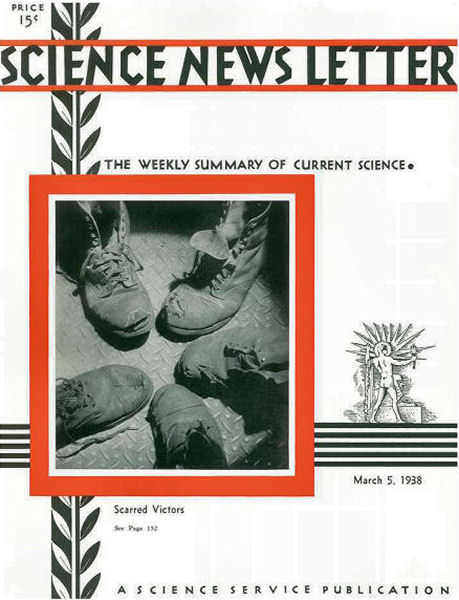From the March 5, 1938, issue

BATTLE-SCARRED WORK SHOES TESTIFY FOR SAFETY WORK
Eloquent testimony for safety measures among industrial workers are the battered shoes pictured on the cover of this issue of the Science News Letter. They are five out of 150,000 safety shoes, 75,000 pairs, worn last year by the workers of the Bethlehem Steel Company. The toes tell their own story. In each case something heavy dropped upon a shoe, and in each case the worker escaped with no injury or only a minor one. An inner cap of steel on these safety shoes will bear up under terrific impact.
An analysis of accident reports at one of the larger Bethlehem plants indicates that 18 years ago, when safety shoes were practically unheard of, injuries to toes or feet accounted for nearly half of the “lost-time” accidents. Of 213 such accidents that occurred in a year’s time in this pre-safety shoe era, 83 were to toes. Last year, when practically all workers wore safety shoes, there were only seven accidents of this description. Bethlehem’s Director of Safety gives safety shoes the major credit for this striking reduction in toe injuries, typical also of the experience in other plants.
SATURN MAY HAVE TENTH MOON, BRITISH ASTRONOMER SUGGESTS
Saturn, whose nine satellites make it the champion among the planets in this respect, may really have 10 companion bodies, it is now reported to the British science journal, Nature (Feb. 5).
John Miller, London astronomer and member of the British Astronomical Association, suggests that a tenth satellite may be found in the region between the present eighth and ninth satellites of brilliant Saturn. The orbit of the tenth satellite, if it exists, should be about 2 million miles farther out from the one known as Iapetus and 4 million miles inside the orbit of the outermost satellite, Phoebe.
The 6-million-mile gap in space between Iapetus and Phoebe has long intrigued astronomers. If the approximate placing of the satellites follows the astronomical rule known as Bode’s law, then satellite 10 should be found at the distance Mr. Miller suggests.
Bode’s law is a long-known empirical rule which has no physical explanation. The so-called law states that there is a regular progressive increase in the mean distances of the planets from the sun. The law holds good for all the planets except Mercury and Neptune and cannot be regarded, says Mr. Miller, as merely coincidental truth.
If one takes the distance of Mercury’s orbit from the sun as a starting point and calls the distance from Mercury’s orbit to the orbit of Venus 3, then the distance of the other planetary orbits from that of Mercury turns out to be roughly in the geometrical progression 6, 12, 24, etc. This same general relationship seems to apply also to satellites, states Mr. Miller.
In his report to Nature Mr. Miller sets up two tables of values: one for the observed distance in miles between the orbits of the respective known satellites and another giving the distances based on geometrical progression. In most cases the agreement for the nine known satellites is fairly good. There is only one large discrepancy. That is the blank hole in the table which Mr. Miller suggests is the spot for the yet undiscovered satellite.
In 1905, Prof. W.H. Pickering reported a faint satellite of Saturn which has never been confirmed. Mr. Miller suggests that perhaps the tenth satellite is the missing object reported 33 years ago by Pickering.
MODERN PROSPECTING METHODS LOCATE NEW OIL IN ILLINOIS
Oil wells in places regarded as impossible before 1930, located by systematic use of modern scientific prospecting methods, have led to the discovery of eight new oil pools in southern Illinois and the increase of the state’s known oil reserves by at least 100 million barrels, it was reported by Dr. M.M. Leighton, Illinois state geologist.
Found as a result of a planned search, these new oil pools are in an area regarded as barren before 1930. Realizing, as a result of intensive field work, that there should be domes within the great Illinois Basin, the state geologist’s forces, with some private companies, began an intensive search for such oil traps, located a number of probable traps by geophysical methods, and proved the correctness of their findings by bringing in producing wells on eight of them.
Modern prospecting methods have cut drilling losses more than 50 percent. Wildcat drilling (drilling in areas where there are no producing wells) resulted in bringing in oil only once in every 10 attempts during 1937, when the well was sunk only on a “hunch.” When the suspected area was first gone over by geologists with modern methods, the score was one producing well for every four wildcat drillings.
With Illinois oil production already tripled by these new fields, 150 or more geologists working for oil companies are now at work endeavoring to locate new oil pools, declares Dr. Leighton.







